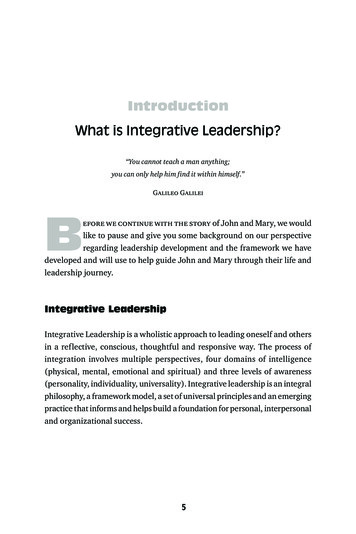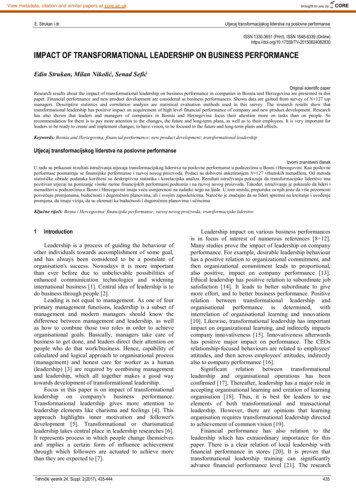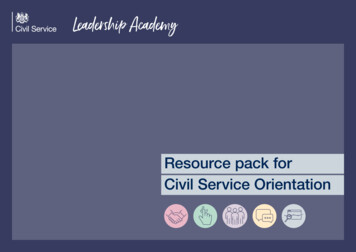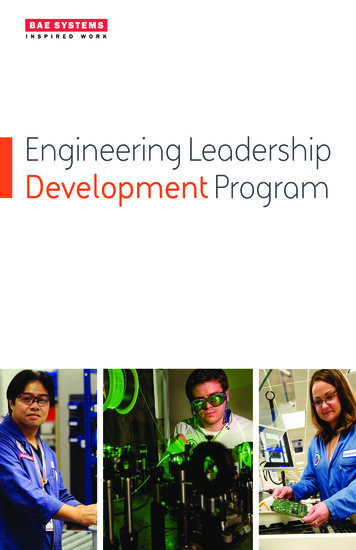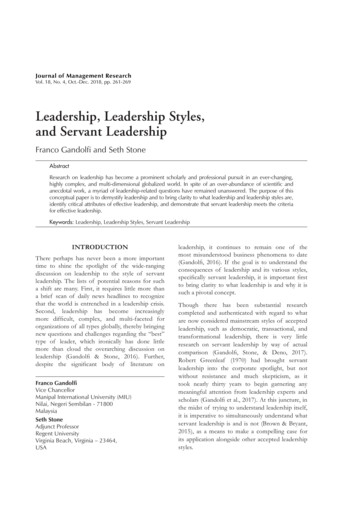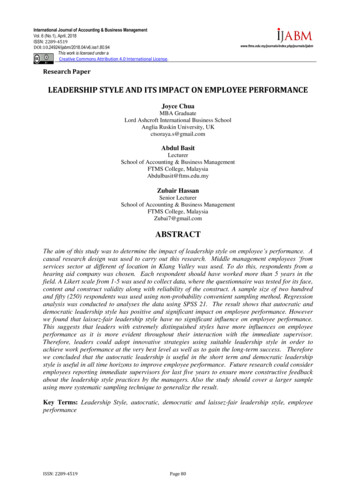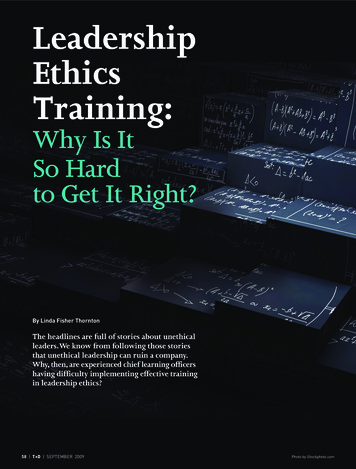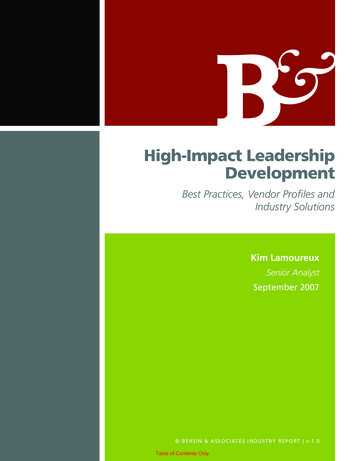
Transcription
High-Impact LeadershipDevelopmentBest Practices, Vendor Profiles andIndustry SolutionsKim LamoureuxSenior AnalystSeptember 2007 BERSIN & ASSOCIATES INDUSTRY REPORT v.1.0Table of Contents Only
High-Impact Leadership Development TABLE OF CONTENTSAbout This Report15Practices and Measures Studied18Study Demographics21Organization Size21Organization Type21Industries23In-Depth Survey Data25Summary of Key Findings 26Case in Point: Executive Engagement at Mellon Financial CorporationThe State of Leadership Development Today2935Defining Talent Management35What Is Leadership Development?36The Difference between Management and Leadership36The Difference between Development and Training39Leadership Development Defined40The Leadership Pipeline42What Is “High Potential?”43Case in Point: How Textron Inc. Defines “High Potential”45Key Business Drivers for Leadership Development481. Improve Internal Candidate Pools / Bench Strength522. Reduce Skills Gaps / Build Competencies543. Grow More Leaders More Quickly554. Business Growth565. Increase Employee Retention Rate576. Prepare for Retirements of Existing Leaders or Other Turnover58Benefits of Leadership Development59The Role of the Leader’s Leader61Generational Leadership62Bersin & Associates September 2007 Not for Distribution Licensed MaterialTable of Contents Only
High-Impact Leadership Development Bersin & Associates Leadership DevelopmentMaturity Model 65Level 1 – Inconsistent Management Training67Level 1 Summary Description70Case in Point: Inconsistent Management Training72Level 2 – Structured Leadership Training72Level 2 Summary Description76Case in Point: Structured Leadership Training76Moving from Level 1 to Level 276Level 3 – Focused Leadership Development79Level 3 Summary Description82Case in Point: Focused Leadership Development84Moving from Level 2 to Level 384Level 4 – Strategic Leadership Development86Level 4 Summary Description90Case in Point: Strategic Leadership Development90Moving from Level 3 to Level 492Moving from Level to Level93Top Industries at Each Maturity Level94Does the Size of the Organization Impact Maturity Level?97Does Revenue Impact Maturity Level?98Human Resources and Leadership Development PerspectivesThe Best Practices of Leadership Development1. Maintain Strong Executive Engagement101103103Impact of Executive Engagement on Leadership Development105Executives Must Own Leadership Development110Case in Point: Creating a High-Performing Culture at NSLIJ110How Can Executives Be Involved?112Case in Point: Talent Development at Textron Inc.115Business Drivers Impact Executive Engagement116Bersin & Associates September 2007 Not for Distribution Licensed MaterialTable of Contents Only
High-Impact Leadership Development Executive Engagement by Maturity Level116Organizational Impact of Executive Engagement117Executive Practices That Drive Organizational Impact120Gaining and Maintaining Executive Engagement122Maturity Model Assessment125Define Tailored Leadership Competencies125Selecting Leadership Competencies128Case in Point: Developing a Competency Model at Informatica129Case in Point: Developing a Competency Model at NSLIJ130How Many Competencies?132Leadership Competency Models133Case in Point: General Electric’s “Catch-All” Model133Case in Point: Focused Leadership Development at Aetna134Leadership Competency Management135Benefits137Maturity Model Assessment140Align with Business Strategy140Importance of Executive Engagement141Case in Point: Leadership Development at Mellon Financial Corporation 142Impact by Maturity Level143Culture, Vision, Mission and Values143Ways for Ensuring Alignment144Business Impact of Strategic Alignment148Driving Improved Business Results149Increasing the Quality and Bench Strength of the Leadership Pipeline150Increasing the Engagement, Retention and Teamwork of Leaders151Improving Overall Employee Retention153Summary154Maturity Model Assessment154Target All Levels of LeadershipBersin & Associates September 2007 Not for Distribution Licensed MaterialTable of Contents Only155
High-Impact Leadership Development The Importance of Targeting All Levels of Leadership155Targeting All Levels of Leadership156Leadership Pipeline Revisited157Leadership Curriculum Model160Case in Point: Identifying Leaders at Alcatel-Lucent161Maturity Model by Targeted Audiences163Measuring the Effectiveness of Leadership Development165Benefits165Five Considerations for Getting Started166Same Quality for Different Levels of Leadership Is Key169Summary170Maturity Model Assessment170Apply a Comprehensive Program DesignLearning and Delivery ApproachesTechnology in Leadership Development1711711731. Increase Reach to a Broader Audience1732. Improve Effectiveness and Efficiency of In-Class Time1733. Reduce Training Expenditures174Online Self-Study174Features That Make e-Learning Engaging1761. Advice from Well-Known Experts1762. Interactivity and Simulations1763. Job-Aids1774. Simple, Easy-to-Use Interface177Workflow Learning and Performance Support177Case in Point: Hewlett-Packard (HP)178Benefits of Performance Support at HP180Results180Virtual Collaboration181Case in Point: Exult185Bersin & Associates September 2007 Not for Distribution Licensed MaterialTable of Contents Only
High-Impact Leadership Development Experiential Learning186On-the-Job Learning187Simulations188Assessments and Coaching190Assessments190Coaching and Mentoring192Blended-Learning Models1941. Exclusively Online1942. Blended Online and Classroom Instruction1973. Exclusively Offline198Assessments, Simulations and Coaching199Summary of Learning Approaches199Comprehensive Learning Approaches by Maturity Level200Case in Point: National Basketball Association (NBA)204Program Format204Measurement and Feedback206Lessons Learned206Case in Point: Sasktel207Pre-Course Assessments207Classroom Session207Post-Course Activities208Measurement and Feedback209Lessons Learned209Maturity Model AssessmentLeadership Development Program Models210210Program Flow Model211Case in Point: Digitas Inc.212Case in Point: Leadership Development at Alcatel-Lucent214Case in Point: Developing Leadership Excellence at Textron219Case in Point: Quiznos222Bersin & Associates September 2007 Not for Distribution Licensed MaterialTable of Contents Only
High-Impact Leadership Development Core and Spoke Model226Case in Point: Philips Medical Systems227Case in Point: Implementing a Coaching Model at Informatica229Case in Point: Air Products232Twenty Considerations for Selecting the Design of a Program234Integrate with Talent Management236Talent Management Integration by Maturity Level238Performance Management240Learning and Development242Succession Management244Talent Strategy, Planning and Recruiting245Case in Point: NSLIJ Prepares Its Employees for Leadership Roles246Sourcing and Recruiting247Compensation247Competency Management250Impact of Executive Engagement on Talent Management Integration250Impact of Talent Management Integration on Business Measures251Maturity Model Assessment253Implement Ongoing Feedback and Evaluation 254How Often Do Companies Evaluate Leadership Programs?255Measurement and Maturity256Case in Point: Cisco Systems258Business Planning and Measurement260How Does a Company Measure for Success?261Bersin & Associates Impact Measurement Framework 263Challenges of Leadership Development 265Business Impact of Leadership Development 268Impact of Executive Engagement272Impact of Leadership Development on Talent Management273Bersin & Associates September 2007 Not for Distribution Licensed MaterialTable of Contents Only
High-Impact Leadership Development The Changing Landscape 2751. Leadership as Part of Talent Management2752. A Stronger Focus on Succession Management2763. Coaching as a Valuable Means for Developing Leaders2764. More Comprehensive Solutions for Learning2775. An Increased Focus on Retention of Leaders2776. An Understanding of Generational Differences278Market Size and Vendor Analysis 279The Vendor Landscape279What Kinds of External Resources Are Available?279For What Types of Services Are Vendors Used?281Market Map: Scalability Versus Breadth of Leadership Topics 283Market Map: Breadth of Services Versus Scalability285Market Map: Market Experience Versus Breadth of Services285Market Map: Targeted Audience287Features and Capabilities at a Glance289How Do You Select a Vendor?289Conclusion 296Bottom Line300Appendix I: Leadership DevelopmentMaturity Model Grid301Appendix II: Case Study305Changing the Way Top Talent Is Managed inHealthcare: Building a High-Performance Cultureat North Shore-Long Island Jewish Health System306In This Case Study306Company Overview307The Business Environment308Business Challenges That OccurredThe NSLIJ Learning EnvironmentBersin & Associates September 2007 Not for Distribution Licensed MaterialTable of Contents Only310313
High-Impact Leadership DevelopmentThe Center for Leadership and Innovation 313Technology315Creating a High-Performing Culture316Expectations Set Early on at NSLIJ316Developing Talent Is a Leadership Competency316Identifying High Potentials317Case in Point: Defining Leadership Competencies in Healthcare318Developing High Potentials320Succession Planning at NSLIJ321360-Degree Feedback Process324Talent Development Programs325Learning Programs325Enrichment Programs325Core Management Development325Operational Performance Solutions326Experiential Learning327Patient Safety Institute330Fellowships330Administrative Fellowship Program331Critical Care Nurse Fellowship Program333University Programs334Hofstra University334State University of New York at Farmingdale334Case Western Reserve University335eCornell Distance Learning335Results336Lessons Learned338Looking Forward339Conclusion339Bersin & Associates September 2007 Not for Distribution Licensed MaterialTable of Contents Only
High-Impact Leadership Development10Appendix III: Case Study341Coaching as a Valuable Means for DevelopingLeaders: Driving Performance at Informatica342In This Case Study342Informatica: An Overview343The Informatica Learning Environment343Management Core Curriculum344Competency-Based CurriculaThe Pfeifer Coaching Model (PCM)345346Coach-Based Model348What Makes the Pfeifer Coaching Model Different?349How Effective Is s of PCM355Measurements and Results356Lessons Learned359Best Practices of Informatica’s Management Core Curriculum360Conclusion362Appendix IV: Cases in Point363Summary of Case Studies and Best Practices364Case in Point: Aetna366Case in Point: Alcatel-Lucent369Case in Point: Business Services Firm376Case in Point: Cisco Systems382Case in Point: Digitas Inc.385Case in Point: EquiFirst Corporation389Case in Point: Erie Insurance Group397Case in Point: Hewlett-Packard (HP)404Case in Point: National Basketball Association (NBA)408Case in Point: Philips Medical Systems – Ultrasound411Bersin & Associates September 2007 Not for Distribution Licensed MaterialTable of Contents Only
High-Impact Leadership Development11Case Study: Quiznos416Case in Point: Sasktel420Case in Point: Textron Inc.423Appendix V: Vendor Profiles 427AchieveGlobal 430Company Offering Overview430Features / Capabilities Summary430Other Services431Key Differentiators431Bersin Analysis432Company Contact Information432American Management Association (AMA) 433Company Offering Overview433Features / Capabilities Summary433Other Services434Key Differentiators434Bersin Analysis435Company Contact Information436BTS 437Company Offering Overview437Features / Capabilities Summary437Other Services438N/A438Key Differentiators438Bersin Analysis439Company Contact Information439Center for Creative Leadership (CCL) 440Company Offering Overview440Features / Capabilities Summary441Bersin & Associates September 2007 Not for Distribution Licensed MaterialTable of Contents Only
High-Impact Leadership Development12Other Services442Key Differentiators442Bersin Analysis443Company Contact Information444Development Dimensions International (DDI) 445Company Offering Overview445Features / Capabilities Summary446Other Services446Key Differentiators446Bersin Analysis447Company Contact Information448eCornell 449Company Offering Overview449Features / Capabilities Summary450Key Differentiators450Bersin Analysis451Company Contact Information452Human Capital Institute (HCI) 453Company Offering Overview453Features / Capabilities Summary454Other Services454Key Differentiators454Bersin Analysis455Company Contact Information456Impact Achievement Group, Inc. (IAG) 457Company Offering Overview457Features / Capabilities Summary458Other Services458Key Differentiators458Bersin & Associates September 2007 Not for Distribution Licensed MaterialTable of Contents Only
High-Impact Leadership Development13Bersin Analysis459Company Contact Information459Ken Blanchard Companies 460Company Offering Overview460Features / Capabilities Summary460Other Services461Key Differentiators461Bersin Analysis461Company Contact Information463LeaderPoint 464Company Offering Overview464Features / Capabilities Summary464Other Services465Key Differentiators465Bersin Analysis466Company Contact Information467Ninth House 468Company Offering Overview468Features / Capabilities Summary469Other Services469Key Differentiators469Bersin Analysis470Company Contact Information471Omega Performance 472Company Offering Overview472Features / Capabilities Summary473Other Services473N/A473Key Differentiators473Bersin & Associates September 2007 Not for Distribution Licensed MaterialTable of Contents Only
High-Impact Leadership Development14Bersin Analysis474Company Contact Information475SkillSoft 476Company Offering Overview476Features / Capabilities Summary477Other Services477Key Differentiators477Bersin Analysis478Targeted Learning 480Company Offering Overview480Other Services481Key Differentiators481Bersin Analysis482Appendix VI: Glossary of Terms 484Appendix VII: Table of Figures489About Us497About This Research497Bersin & Associates September 2007 Not for Distribution Licensed MaterialTable of Contents Only
High-Impact Leadership Development15About This ReportKEY POINTMost executivesunderstand that thefuture success oforganizations lies in thebench strength of leadersand in the developmentalopportunities that areafforded to them.Leadership development (LD) has quickly become one of the mostimportant initiatives for HR and learning and development (L&D)managers. In fact, most executives understand that the future successof organizations lies in the bench strength of leaders and in thedevelopmental opportunities that are afforded to them. In our HighImpact Talent Management research , we asked more than 700 HR andL&D managers to rank their top talent-driven challenges. These managersindicated that “filling gaps in the leadership pipeline ” (51 percentof respondents) was their number one challenge – with “creating aperformance-driven culture” (46 percent of respondents) and “difficultyfilling key positions” (38 percent of respondents) rounding out the topthree talent challenges. Filling gaps in the leadership pipeline is clearly anew corporate imperative.Developed after more than a year of research, this report answers keyquestions related to strategy, business impact and common challenges inthe area of leadership development, including the following. How do organizations define leadership development? Do organizations recognize leadership development as part of theirtalent management systems? “Leadership development” is an ongoing systematic process that assesses, developsand grows talent at all levels of management, and integrates tightly with performancemanagement and succession management. For more information, High-Impact Talent Management: Trends, Best Practices andIndustry Solutions, Bersin & Associates / Josh Bersin, May 2007. Available to researchmembers at www.elearningresearch.com or for purchase at www.bersin.com/hitm. “Leadership pipeline” refers to an organization’s ongoing need to have a poolof talent that is readily available to fill positions at all levels of management (as wellas other key positions) as the company grows. At each level, different competencies,knowledge and experiences are required, and (to keep the pipeline filled) theorganization must have programs designed to develop appropriate skills sets. (Alsoknown as the “leadership bench.”) For more information, High-Impact Talent Management: Trends, Best Practices andIndustry Solutions, Bersin & Associates / Josh Bersin, May 2007. “Talent management” is a set of integrated organizational processes designedto attract, manage, develop, motivate and retain key people. The goal of a talentmanagement program is to create a highly responsive, high-performance, sustainableorganization that meets its business targets.Bersin & Associates September 2007 Not for Distribution Licensed MaterialTable of Contents Only
High-Impact Leadership Development16 How do organizations integrate leadership development with otherHR functions, such as recruiting and compensation? What are the key business drivers for leadership development? What are the hot topics for leadership development? How does leadership development fit into an organization’s strategicbusiness plan? What issues or challenges are businesses facing in developing relevantand effective leadership programs? How has leadership development evolved over the last few years? What is the maturity level of an organization as it relates toleadership development programs, processes and strategies? What does the target audience of leadership development look like? To what extent are senior executives playing a role in leadershipdevelopment? How are they contributing? What tools, methodologies and approaches do organizations use todevelop leaders? What factors contribute to the success or failure of leadershipdevelopment initiatives? What factors influence the adoption and longevity of leadershipdevelopment initiatives? Where are there opportunities for organizations to enhance theirleadership development strategies and programs? How do leadership development strategies and programs impactan organization? How are organizations measuring and evaluating theirleadership programs?This in-depth industry study is based on extensive research into thiscomplex and rapidly evolving market, and includes: In-depth interviews with more than 40 leadership development andL&D managers responsible for enterprise leadership development;Bersin & Associates September 2007 Not for Distribution Licensed MaterialTable of Contents Only
High-Impact Leadership Development17 Detailed briefings with 14 leadership development content andservice providers; and, An extensive quantitative survey of 778 leadership development andL&D managers identifying key drivers, business challenges and trendsin leadership development.This report discusses trends, insights and specific recommendations thatwill help organizations understand how to successfully build, improveand manage their leadership pipelines. Throughout this report, you willfind examples of best practices from a number of companies of differentsizes and industries – and at different levels of maturity.We hope this report will provide actionable and insightful bestpractices for training, human resources and organizational development(OD) executives who are charged with the critical task of helpingorganizations improve current leadership and prepare for the impendingshortage of leaders at all levels within the organization. Among otherthings, organizations will ultimately gain an understanding of how to: Take steps to implement each of the six best practices; Develop relationships with senior executives in order to gain theircommitment for and involvement in leadership development; Develop a business case that includes critical information anddemonstrates the business impact; Identify an approach for developing a high-value set of corecompetencies for a given organization; Think through an appropriate and effective leadership programmodel that includes opportunities for learning, applicationand reinforcement; Instill steps into leadership development processes that will ensurestrategic business alignment; “Actionable information” provides data that can be used to make specific businessdecisions. Actionable information is specific, consistent and credible. “Competencies” refers to a set of clearly defined skills, behaviors and knowledgethat are used to evaluate, assess and develop people. “Core values” are higher-levelcompetencies (e.g., quality, customer service) that are often defined by the CEO, and useduniversally to evaluate and coach every employee in the company. Typically, there are onlya few of these (five or fewer) and they are widely marketed throughout the organization.Bersin & Associates September 2007 Not for Distribution Licensed MaterialTable of Contents Only
High-Impact Leadership Development18 Use succession management and performance management processes to develop and maintain a solid leadership pipeline; Select a vendor that is best-suited and the most capable for providingsolutions that will drive improved performance; Develop an effective and realistic leadership program evaluationstrategy; and, Create a plan for moving up the Bersin & Associates LeadershipDevelopment Maturity Model in a reasonable and timely way (formore information, please see section, “Moving from Level to Level”).Practices and Measures StudiedThe goal of our research was to understand best practices in leadershipdevelopment of high-performing organizations. Through this research,we were able to understand the impact that each best practice has onthe overall effectiveness of an organization’s leadership developmentefforts. From there, we defined four levels of organizational maturityas each relates to leadership development. Finally, we were able todistinguish the impact that companies achieve at the varying levels of theMaturity Model based on four key business measures (see Figure 1).We discuss each best practice and Level of Maturity in great detail laterin this report. In addition, these four business measures are discussedthroughout the report, as well as in the section, “Business Impact ofLeadership Development.”One of the toughest challenges in business process research is tryingto truly understand the business outcomes that result from a givenapproach. Ideally, we would like to see a direct relationship betweena company’s leadership development program and an increase inretention, sales or profitability (just to name a few areas). Unfortunately, “Succession management” refers to an organization’s processes for identifying,selecting and managing successors, as well as the processes of career planning andtalent migration. Succession management must be closely aligned with learning anddevelopment. “Performance management” refers to all of the processes managers perform toeffectively lead, manage, assess and develop employees. This typically includes goalsetting, cascading goals, self-assessment, manager assessments, 360-degree assessmentsand development planning.Bersin & Associates September 2007 Not for Distribution Licensed MaterialTable of Contents Only
High-Impact Leadership Development19Figure 1:1: hipDevelopmentLeadershipBest Practices1. Senior managementLeadershipMaturityBusinessImpact1. Inconsistent1. Improved2. Structured2. Increased quality3. Focused3. Increased engagement,4. Strategic leadership4. Improved overallmanagementtrainingengagement2. Definedcompetenciesleadershiptraining3. Business strategyalignment4. Multiple levels ofmanagementleadershipdevelopment5. ComprehensiveProgram Design6. Talent managementintegrationdevelopmentbusiness resultsand bench strengthof leadership pipelineretention andteamwork of leadersemployee retentionSource: Bersin & Associates, 2007.because organizations are so complex and leadership development is so“intangible” this is never fully possible. Such research (if undertaken)would also never fully take into account such factors as a company’sproduct strategy or competitive environment, or company-specific issueslike marketing, financial pressures and technology maturity.Since we are focused on providing highly actionable and “pragmatic”information for HR and L&D professionals, we analyzed the impact ofvarious processes on the four business measures as described in Figure 2.These impact measures (while not direct business outcomes) are four ofthe most widely recognized HR measures of business success: Driving performance; Increasing leadership bench strength; Increasing leadership retention; and, Increasing employee retention.Bersin & Associates September 2007 Not for Distribution Licensed MaterialTable of Contents Only
Human Resources and Leadership Development Perspectives 101 The Best Practices of Leadership Development 103 1. Maintain Strong Executive Engagement 103 Impact of Executive Engagement on Leadership Development 105 Executives Must Own Leadership Development 110 Case in Point: Creating a High-Performing Culture at NSLIJ 110
